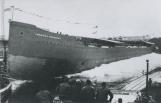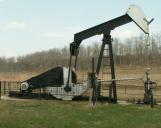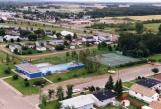1
There may have been tensions between the farming community and the oil companies over the differing values that the land had to offer. No doubt, the discovery of oil and the various oil companies investment in the Redwater area was truly progressive. Redwater, a tiny hamlet with no electricity, no running water, very few phones and even fewer automobiles was quickly brought into the 20th century.Imperial Esso brought in many of its employees as well as offering work for local people. It also invested in establishing good housing with electricity and running water. The town prospered from the discovery of oil. Imperial not only brought these fundamental comforts to the community but it also addressed the town's recreational and social needs. The company donated a great deal of land from the Imperial Townsite, and financial support for recreational pursuits. The community now enjoys a recreational complex which includes a hockey/skating arena, curling rink, a golf club house leading to a well groomed golf course and a swimming pool. Land was also given to build new and larger churches to satisfy the burgeoning population. These benefits to being an oil boom town are only a few of the examples of how the discovery of oil has benefited our community.
3
Aerial view of Redwater taken in 1998. This view shows the golf course and recreation facilities.Circa 1998
Redwater, Alberta, Canada

4
Oil is still being pumped out of the Redwater field. Related oil field businesses continue to thrive in this area. Many plants including the Esso Gas Plant and the Agrium Fertilizer Plant, first established by Imperial Esso, continue to actively employ a large number of workers from the community and beyond. Some who left the plow to work in the oil fields, have again returned to their farms, but many continue to draw their livelihoods from various oil field industries.5
Imperial Redwater at the ChristeningCirca 1951
Port Arthur, Ontario
 Credits:
Credits:Imperial Oil Review, Vol. 35 No. 1 February March 1951
Imperial Oil Fonds, Glenbow Archives, Calgary, Alberta.
6
The importance of the Redwater oil discovery was such a significant find that Imperial even named one of their Great Lakes tankers the S.S. Redwater. The S.S. Redwater along with the S.S. Leduc were, at that time, the largest oil tankers in the Great Lakes service. These ships had a capacity to carry 115,000 barrels of oil. A pipeline was constructed to deliver oil to eastern Canada. Redwater was the beginning point of this 1929 mile long pipeline.Interprovincial Pipeline constructed a thirty-one mile line was built from Redwater to Edmonton which gave Redwater the distinction of being the starting point of what was to become the longest crude pipeline in the world (Redwater to Port Credit, Ont. 1929 miles)
7
Pump jack at the original site of the Imperial Discovery Well Redwater #1Circa 2008
Redwater, Alberta, Canada
 Credits:
Credits:Rosemary Neathway
8
Redwater proudly displays a fully operational pump jack in one of its parks to commemorate the oil industry in this area. A pump jack also graces the site of Discovery Well Redwater #1, although no longer used, as the well has been automated. . It stands as a monument to the first well drilled in the Redwater oil field. This first well, that was drilled in the Redwater oil field is still producing oil after sixty years. Another Redwater park proudly displays the derrick from the Discovery Well Redwater #1. Fin Lineham hauled this derrick from Eyot Lake to the Discovery Well site in the summer of 1948.In 1988 Larry Chekerda spearheaded the task of salvaging the abandoned derrick parts from the Esso Gas Plant site. The rusting derrick was painted and re-assembled beside the Multiplex, now known as Provident Place. Here it will remain as a legacy and tribute to oil field activity in this area. What a valued tourist attraction this has become for the town. In 1998 a Legacy Committee was formed to construct a memorial to the oil industry in the Redwater area. The committee hopes to build a monument and a self-guided interpretive centre beside the Redwater derrick.
9
Imperial Redwater #1. Picture was taken on the third day of drilling (July 25, 1948).25 July 1948
Redwater, Alberta, Canada

11
As we compile this 2008 project, the Town of Redwater sits poised on the threshold of another oil boom. Currently our area, known as the Industrial Heartland, is being developed to accommodate a number of heavy oil upgraders. Land has been acquired and multiple pipelines now criss-cross the area in preparation for the proposed upgraders. As well, a test field area is currently under scrutiny for a carbon capture project. This is seen as an environmentally friendly method of containing industrial pollutants. The very large reef that produced the oil will now be used to capture the pollutants from oil related industries.With the proposed upgraders a noticeable feeling of anticipation has enveloped the Redwater community as a modern day oil boom is presently on the horizon. Enthusiasm over the potential for growth has spread throughout the community. Some optimistic souls think of this as a modern day oil boom and think that history will repeat itself. If you asked the old timers who were here, they will tell you nothing rivals the excitement of the boom of 1948.
12
The view from below, looking upwards towards the top of the Discovery Derrick.Circa 1989
Redwater, Alberta, Canada

13
Looking southeast from atop the Discovery Derrick, swimming pool in foreground.Circa 1989
Redwater, Alberta, Canada


